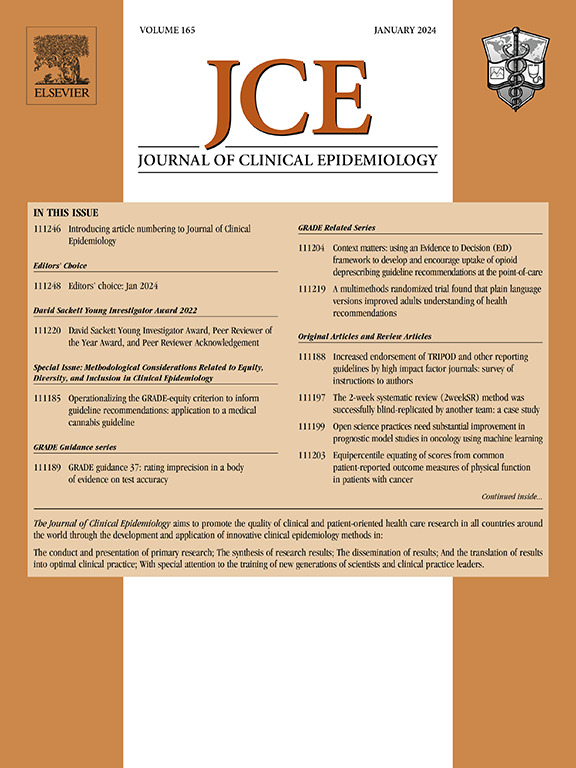The EORTC QLU-C10D distinguished better between cancer patients and the general population than PROPr and EQ-5D-5L in a cross-sectional study
IF 7.3
2区 医学
Q1 HEALTH CARE SCIENCES & SERVICES
引用次数: 0
Abstract
Objectives
Health state utility (HSU) instruments for calculating quality-adjusted life years, such as the European Organisation for Research and Treatment of Cancer (EORTC) Quality of Life Utility - Core 10 Dimensions (QLU-C10D), derived from the EORTC QLQ-30 questionnaire, the Patient-Reported Outcome Measurement Information System (PROMIS) preference score (PROPr), and the EuroQoL-5-Dimensions-5-Levels (EQ-5D-5L), yield different HSU values due to different modeling and different underlying descriptive scales. For example the QLU-C10D includes cancer-relevant dimensions such as nausea. This study aimed to investigate how these differences in descriptive scales contribute to differences in HSU scores by comparing scores of cancer patients receiving chemotherapy to those of the general population.
Study Design and Setting
EORTC QLU-C10D, PROPr, and EQ-5D-5L scores were obtained for a convenience sample of 484 outpatients of the Department of Oncology, Charité – Universitätsmedizin Berlin, Germany. Convergent and known group’s validity were assessed using Pearson's correlation and intraclass correlation coefficients (ICC). We assessed each descriptive dimension score's discriminatory power and compared them to those of the general population (n > 1000) using effect size (ES; Cohen's d) and area under the curve (AUC).
Results
The mean scores of QLU-C10D (0.64; 95% CI 0.62-0.67), PROPr (0.38; 95% CI 0.36-0.40), and EQ-5D-5L (0.72; 95% CI 0.70-0.75) differed significantly, irrespective of sociodemographic factors, condition, or treatment. Conceptually similar descriptive scores as obtained from the HSU instruments showed varying degrees of discrimination in terms of ES and AUC between patients and the general population. The QLU-C10D and its dimensions showed the largest ES and AUC.
Conclusion
The QLU-C10D and its domains distinguished best between health states of the two populations, compared to the PROPr and EQ-5D-5L. As the EORTC Core Quality of Life Questionnaire (QLQ-C30) is widely used in clinical practice, its data are available for economic evaluation.
Plain Language Summary
The assessment of dimensions of health-related quality of life (HRQoL), such as physical functioning or depression, is important to cancer patients and physicians for treatment and side effect monitoring. Descriptive HRQoL is measured by patient-reported outcomes measures (PROM). The European Organisation for Research and Treatment of Cancer (EORTC) QLQ-C30 questionnaire and the Patient-Reported Outcome Measurement Information System (PROMIS) are the most common PROM in the clinical HRQoL assessment. In recent years, multidimensional preference-based HRQoL measures were developed using these PROM as dimensions. These preference-based measures, also referred to as health state utility (HSU) scores, are needed for economic evaluations of treatments. The QLQ-C30's corresponding HSU score is the quality-of-life utility measure-core 10 dimensions (QLU-C10D), and PROMIS’ HSU score is the PROMIS preference score (PROPr). Both new HSU scores are frequently compared to the well-established EuroQoL-5-dimensions-5-levels (EQ-5D-5L). They all conceptualize HSU differently, as they assess different dimensions of HRQoL und use different models. Both the QLU-C10D and the PROPr have thus shown systematic differences to the EQ-5D-5L but these were largely consistent across the subgroups. Convergent and known groups validity can therefore be considered established. However, as HSU is a multidimensional construct, it remains unclear how differences in its dimensions, for example, its descriptive scales, contribute to differences in HSU scores. This is of importance as it is the descriptive scales that measure clinical HRQoL. We investigated this question by assessing each dimension’s ability to distinguish between a sample of 484 cancer patients and the German general population. We could show that the ability to distinguish depended on the domain: for example, for depression, the QLU-C10D and EQ-5D-5L distinguished clearer, while for physical function, PROMIS did. Overall, the QLU-C10D and its dimensions distinguish best between cancer patients and general population.
在一项横断面研究中,EORTC QLU-C10D 比 PROPr 和 EQ-5D-5L 更能区分癌症患者和普通人群。
目的:用于计算质量调整生命年的健康状态效用(HSU)工具,如 EORTC QLU-C10D、PROMIS 偏好评分(PROPr)和 EQ-5D-5L 等,由于建模方式和基本描述量表不同,产生的 HSU 值也不同。例如,QLU-C10D 包括恶心等与癌症相关的维度。本研究旨在通过比较接受化疗的癌症患者和普通人群的得分,调查这些描述性量表的差异如何导致 HSU 分数的差异:德国柏林夏里特大学肿瘤学系的 484 名门诊患者的 EORTC QLU-C10D、PROPr 和 EQ-5D-5L 分数均为方便抽样调查所得。我们使用皮尔逊相关性和类内相关系数评估了收敛有效性和已知组有效性。我们使用效应大小(ES;Cohen's d)和曲线下面积(AUC)评估了每个描述性维度得分的鉴别力,并与普通人群(n>1,000)进行了比较:QLU-C10D(0.64;95%CI 0.62-0.67)、PROPr(0.38;95%CI 0.36-0.40)和 EQ-5D-5L(0.72;95%CI 0.70-0.75)的平均得分差异显著,与社会人口因素、病情或治疗无关。从 HSU 工具中获得的概念相似的描述性分数在 ES 和 AUC 方面显示出患者和普通人群之间不同程度的差异。QLU-C10D及其维度的ES和AUC最大:结论:与 PROPr 和 EQ-5D-5L 相比,QLU-C10D 及其维度最能区分两种人群的健康状况。由于 EORTC QLQ-C30 广泛应用于临床实践,其数据可用于经济评估。
本文章由计算机程序翻译,如有差异,请以英文原文为准。
求助全文
约1分钟内获得全文
求助全文
来源期刊

Journal of Clinical Epidemiology
医学-公共卫生、环境卫生与职业卫生
CiteScore
12.00
自引率
6.90%
发文量
320
审稿时长
44 days
期刊介绍:
The Journal of Clinical Epidemiology strives to enhance the quality of clinical and patient-oriented healthcare research by advancing and applying innovative methods in conducting, presenting, synthesizing, disseminating, and translating research results into optimal clinical practice. Special emphasis is placed on training new generations of scientists and clinical practice leaders.
 求助内容:
求助内容: 应助结果提醒方式:
应助结果提醒方式:


